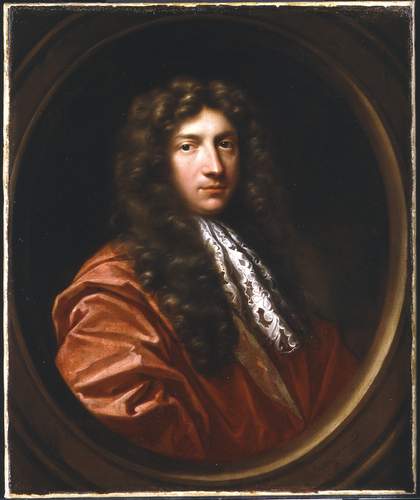
Fig.1
Simon Du Bois
Portrait of a Gentleman, probably Arthur Parsons MD
1683
T07469
This painting is in oil paint on canvas measuring 769 x 642 mm (fig.1). Although the fine, plain woven, linen canvas no longer has its tacking edges, cusping on all four sides indicates that the dimensions are original.1 The support is now lined onto cotton canvas with wax-resin adhesive and mounted on a stretcher contemporary with the lining.
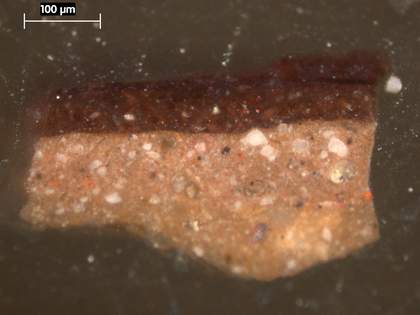
Fig.2
Cross-section through the red garment, photographed at x250 magnification. From the bottom upwards: thin scraping of yellow ground; pale red ground; opaque red underpainting; possibly two layers of translucent crimson glaze
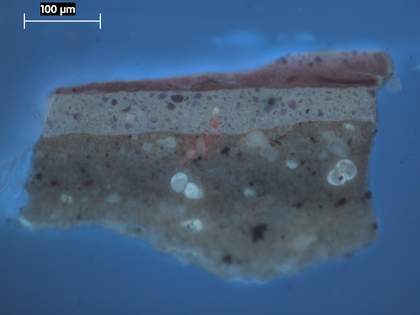
Fig.3
The same cross-section as in fig.2, photographed at x250 magnification in ultraviolet light. The brightly fluorescing spherical particles are lead soap aggregates
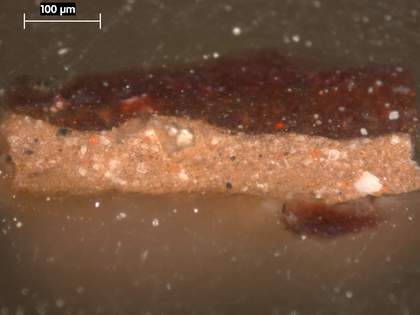
Fig.4
Another cross-section from the red garment, photographed at x250 magnification. From the bottom upwards: thin scraping of yellow ground; pale red ground; opaque red underpainting; possibly two layers of translucent crimson glaze
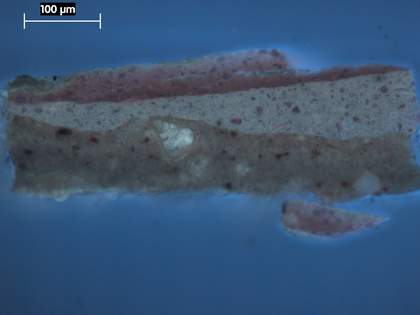
Fig.5
The same cross-section as in fig.4, photographed at x250 magnification in ultraviolet light. The brightly fluorescing spherical particles are lead soap aggregates
The ground is made up of two coats of paint (fig.2). The first layer is thin and was scraped hard into the canvas weave to produce a smooth surface. It was probably applied by the artist after the canvas was stretched on its original stretcher, since there is a slight lip visible near the top edge of the cropped original canvas; this might mark the edge of the ground layer where it met the original turnover edge. It is yellowish in colour and it is composed of yellow ochre, chalk, vermilion, bone black and lead white, probably bound together in oil.2 The second layer of ground is opaque pale red in colour and it is composed of vermilion, lead white, chalk and bone black. This layer also contained red lead, which may be associated with the production of the lead soap aggregates found within it (figs.3–5).
No underdrawing is apparent with any means of examination. In general the paint was applied rather thinly with low impasto for highlights and small details. The paint layer in the dark background is very thin. The shadows around the face were made by laying a thin brown glaze over the flesh tone.
The paint of the drapery is more substantial and the brush marks are clearly visible, particularly in the lace collar. The artist used orpiment mixed with earth colours, yellow lake, smalt and lead white to paint the lapel of the sitter’s robe. The red drapery was built up with two translucent glaze layers over the opaque red underpainting (figs.2–5). The first glaze layer is semi-transparent, consisting of red lake, vermilion, earth pigments; chalk; gypsum; smalt; yellow lake; lead white and black. The smalt would have acted as a drier for the poorly drying lake pigment, whilst the chalk would have given bulk to the paint and helped retain the artist’s brushwork while the paint dried. The medium of this layer fluoresced a strong green in ultraviolet light indicating the presence of natural resin in the medium. The second glaze layer consists almost entirely of red lake with small additions of vermilion and lead white. This did not fluoresce in the same way. With low magnification glittery material can be seen in the deep red glaze on the shadows of the sitter’s robe. Under high magnification this material looks like large clumps of pale yellow or white crystalline material. These could not be identified specifically;3 they may relate to some separation effect in the artist’s medium, or perhaps they are unblended pigment, only partially bound by the paint medium causing internal light scatter and giving a ‘sparkly’ effect. The red lake dyestuff is likely to be of scale insect origin (kermes, cochineal, lac) as it does not have the characteristic fluorescence of madder.
The single layer of natural resin varnish is not likely to be original.
January 2023
